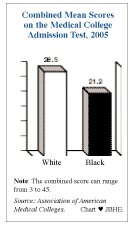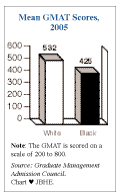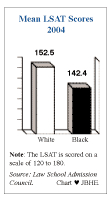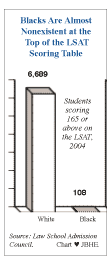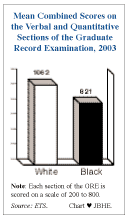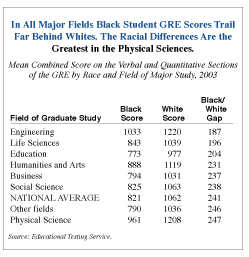| The Widening Racial Scoring Gap on Standardized Tests for Admission to Graduate School On all of the standardized tests for admission to graduate and professional schools, the racial scoring gap is large and in many cases wider than the gap between blacks and whites on the ACT and SAT standardized tests for undergraduate admissions. In all cases the gap on these graduate admissions tests has remained unchanged or widened in recent years. The persisting racial gap on these standardized tests demonstrates the continuing need for race-sensitive admissions programs at our leading graduate and professional schools.
African-American enrollments in graduate school are now at an all-time high. About 160,000 black students are currently enrolled in graduate and professional schools in the United States. This is an increase of more than 34 percent in the past decade. The sharp increase in the number of blacks pursuing graduate education is one of the brightest items of good news that we report in this journal.
But data on black scores on the standardized tests for admission to graduate schools show a persistent and often growing racial gap with whites. The racial scoring gap on graduate and professional school entrance tests makes clear the importance of maintaining affirmative action admissions programs at these graduate institutions. Abort affirmative action and the numbers and percentages of blacks in our leading graduate and professional schools would drop to very low levels. Before we begin our analysis of black results on graduate admissions tests, it must be noted here that blacks admitted to our graduate and professional schools under affirmative action programs tend nevertheless to be qualified students entirely capable of handling the rigorous curriculum at these institutions. JBHE surveys of the graduation rates at our leading business, law, and medical schools show that black students — many, if not most, of whom were admitted under affirmative action guidelines — graduate at very high rates. In many cases their graduation rates approach 100 percent, and in almost all cases the black student graduation rate at these graduate and professional schools is very close to the graduation rate for white students. Contrary to irresponsible propaganda from conservative opponents of affirmative action, racial preferences are not setting up young blacks for failure. For example, JBHE research shows that the black student graduation rate at the law schools at Columbia, Cornell, Georgetown, Northwestern, the University of Michigan, the University of Texas, and the University of Virginia is close to 100 percent. The same holds true for business schools at Dartmouth, MIT, Northwestern, Chapel Hill, and Stanford. At the medical schools at Vanderbilt, the University of Chicago, the University of Pittsburgh, and the University of Virginia, the black student graduation is near perfect. Thus the evidence is strong that giving an admissions preference to a black student at one of our leading graduate or professional schools is not lowering an institution's academic standards, nor is it admitting a student who is underqualified to do the work. Let's first look at the results on the admissions tests used to gauge a student's qualifications for professional schools. About 20 percent of black graduate school students in the United States are enrolled in professional schools of business, law, and medicine. In order to win admission to these professional schools, black college students take specialized standardized tests for their particular discipline. Good test results on the Law School Admission Test, the Graduate Management Admission Test, and the Medical College Admission Test — along with strong academic performance in college — are the entrance tickets to law, business, and medical schools in the United States. Therefore, it is important to see how black students are currently performing on these tests and whether they are making progress in closing the racial scoring gap with whites.
Black Student Score Results on
The competition for places in U.S. medical schools is among the most intense in higher education. Admissions officers place great emphasis on an applicant's scores on the Medical College Admission Test and on his or her grade point average in college, particularly in science courses. In 2005 the mean combined score for black students who took the Medical College Admission Test was 21.2. (Each of the three sections of the MCAT test is scored on a scale of 1 to 15.) For whites, the mean score on the combined three portions of the MCAT test was 28.5. Therefore, the white score was about 18 percent higher than the mean score for blacks. The racial gap in MCAT scores has been virtually unchanged for the past decade. The mean total college grade point average for black applicants to medical school in 2005 was 3.18. For whites, the average GPA was 3.54. If we examine grades in the all-important science courses, the mean black GPA was 2.99. For whites, the figure is 3.44.
If these institutions were to choose their students solely on test scores and college grades, it is clear that in the intense competition for places at medical schools in the United States, African Americans would be at a severe disadvantage in relation to the highest scoring whites. Under these circumstances no blacks would be admitted to the nation's most selective schools of medicine. The test results highlight the importance of continuing affirmative action admissions at U.S. medical schools. Without a continuing flow of blacks and other minorities into U.S. medical schools, inner-city areas and predominantly black rural areas would be faced with severe shortages of medical personnel. This is because white physicians rarely want to set up practice in these areas. Thus any reduction in the number of black medical doctors would create a public health crisis in the United States. The Racial Scoring Gap on the Test for
Students seeking admission to graduate schools of business are in most cases required to take the Graduate Management Admission Test. In 2005, 8,448 African Americans took the GMAT test. They made up 7.9 percent of all GMAT test takers that year. The mean black score on the GMAT was 425. (The test is scored on the familiar 200 to 800 scale used for each section of the SAT test.) For whites, the mean GMAT score was 532. This is 107 points or 18 percent higher than the mean score for blacks. The racial scoring gap on the GMAT test has increased in recent years. In 2003 the scoring gap was 101 points. The next year the gap increased to 104 points. And now the gap has increased further to 107 points.
The average GMAT score for admitted students at the nation's leading business schools is over 700. Perhaps only 1 or 2 percent of all black GMAT test takers score at this level. Therefore, without continuing affirmative action admissions programs at Harvard, Penn, Stanford, Northwestern, MIT, and other top MBA programs, the nation's leading business schools will have very few black students. The latest JBHE survey shows that blacks make up about 5 percent of the students at the nation's leading business schools. If affirmative action admissions programs were to be discontinued, African-American enrollments at these schools might drop by 75 percent. Very Few Blacks Score at the Highest Levels
In 1998 the mean score of white students taking the Law School Admission Test (LSAT) was 151.96. (The LSAT is graded on a scoring scale of 120 to 180.) The mean score for black students taking the test that year was 141.80, about 17 percent lower than the mean score of whites. The latest data shows a slight improvement for both blacks and whites, but there was no progress in closing the racial scoring gap. In 2004 the mean score for whites on the LSAT was 152.47. For blacks, the mean score was 142.43. The 10 point, or 17 percent, scoring gap has remained constant throughout the period with only very minor fluctuations. Students seeking admission to the nation's highest-ranked law schools such as Yale, Harvard, and Stanford have a mean LSAT score of about 170. Data obtained by JBHE from the Law School Admission Council shows that very few blacks nationwide score at this level.
In 2004, 10,370 blacks took the LSAT examination. Only 29 blacks, or 0.3 percent of all LSAT test takers, scored 170 or above. In contrast, more than 1,900 white test takers scored 170 or above on the LSAT. They made up 3.1 percent of all white test takers. Thus whites were more than 10 times as likely as blacks to score 170 or above on the LSAT. There were 66 times as many whites as blacks who scored 170 or above on the test. Even if we drop the scoring level to 165, a level equal to the mean score of students enrolling at law schools ranked in the top 10 nationwide but not at the very top, we still find very few blacks. There were 108 blacks scoring 165 or better on the LSAT in 2004. They made up 1 percent of all black test takers. For whites, there were 6,689 test takers who scored 165 or above. They made up 10.6 percent of all white students who took the LSAT examination. The nation's top law schools could fill their classes exclusively with students who scored 165 or above on the LSAT. But if they were to do so, these law schools would have almost no black students. The Widening Racial Scoring Gap on the Graduate Record Examination The vast majority of black graduate students do not attend professional schools of law, business, or medicine. Most black students are enrolled in graduate programs in other academic disciplines including education, natural sciences, mathematics, foreign languages, the humanities, the arts, history, psychology, and the social sciences. For these students the important test is the Graduate Record Examination (GRE). This test begins with two analytical writing sections, one where the student is given a choice of topics. The analytical writing section is scored on a scale of 0 to 6. Then there is a 30-minute verbal reasoning test and a 45-minute quantitative section. The test is given on a computer terminal and the test is adaptive, meaning that the test questions are selected based on correct or incorrect responses to previous questions. These two sections are scored on the familiar 200 to 800 scale used for the SAT test. Each year about 300,000 college students seeking admission to graduate programs in fields such as education, the humanities, the natural sciences, and the social sciences sit for the GRE. In 2003, the latest year for which there is complete data available, 27,267 blacks took the GRE test. Therefore, blacks made up 8.8 percent of all students who took the GRE.
In 2003 the mean score for blacks on the combined verbal and quantitative sections of the GRE was 821. For whites, the mean combined score was 1062. Thus the mean white score was 241 points, or 20 percent, higher than the mean score for blacks. This racial scoring gap is even wider than the persistent and growing gap on the SAT test. A decade ago, in 1996, black students had a mean combined score of 798. Since that time there has been a 23 point improvement in black scores on the GRE. But white scores have increased at an even greater rate. In 1996 the combined white score was 1034. Thus, the black-white gap was 236 points in 1996 and 241 points today. In 2003 the mean black score on the analytical writing section was 3.7 on a scale of 0 to 6. For whites, the mean score was 4.5, a difference of about 13 percent. There is no way to compare the trend in the gap on this portion of the GRE because the 0 to 6 scale was recently instituted. Previously the analytical section of the test was scored on the 200 to 800 scale. The GRE scoring gap between blacks and whites varies to a large degree depending on the field of proposed study in graduate school. Black students planning to study in the field of engineering scored on average 187 points below whites who plan to pursue a graduate degree in engineering. In the physical sciences, black students on average scored 247 points below whites. In conclusion, it is clear that the racial gap on all standardized tests for admission to graduate school remains very large. In most cases the racial scoring gap is larger than what exists for the SAT and ACT tests for undergraduate admissions. Given that in the 2003 Grutter Supreme Court decision Justice Sandra Day O'Connor stipulated a 25-year lifetime for the continuation of affirmative action in college and university admissions, it is imperative that the widening of the racial scoring gap in graduate admissions tests be halted at the earliest possible date and progress be made in shrinking or eliminating the gap over the next generation. | |




